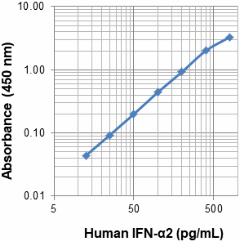- Regulatory Status
- RUO
- Other Names
- IFN-alpha 2B, IFN-alphaA, IFNA2, IFNA2B, Interferon Alpha 2
- Ave. Rating
- Submit a Review
- Product Citations
- publications

-

Coating Buffer B, M4509E12 at 4 µg/mL as capture antibody, Blocked Assay Diluent A (ADA) 1 hr, lyophilized standard 2 hr in Assay Buffer G 50:50 with Matrix A run 12.5 – 800 pg/mL, BL25372 (MT-2) at 0.1 µg/mL 1 hr for detection in ADA, 0.8 µg/mL Avidin HRP in ADA 30 min, TMB F 15 min (in house 76335).
| Cat # | Size | Price | Quantity Check Availability | Save | ||
|---|---|---|---|---|---|---|
| 592709 | 4 pack | 76€ | ||||
Interferons are divided into type I, II, and III. Type I IFNs (IFN-α and IFN-β) are most abundant in number, distribution, and expression. Also, they are highly conserved among mammals in both structure and function. IFN-α2 has been used in the treatment of cancer such as bladder cancer, hepatocellular carcinoma, and leukemia. IFN-α2 augments the suppressed immune functions in patients with head and neck squamous cell carcinoma (HNSCC). IFN-α2 initiated T and NK cell mediated cytotoxicity of tumor cells through IFNγ dependent and independent mechanisms. IFN-α2 enhances suppressed T cell cytotoxicity by stimulation of the perforin-granzyme B system (IFNγ dependent). Also, IFN-α2 induces the expression of perforin-granzyme B in NK cells (NK mediated cytotoxicity, IFNγ independent). In a preliminary study, IFN-α2 appears to be an effective immunostimulator and impacts the clinical outcome in tongue squamous cell carcinoma patients. IFN-α had been used in the treatment of chronic hepatitis C (CHC); nevertheless, IFN-α is relatively unstable and requires frequent parenteral administration. Pegylation of IFN-α, polyethylene glycol (PEG)-IFN-α, reduces in vitro activity but increase the stability and plasma half-life of IFN-α; therefore, PEG-IFN-α has replaced IFN-α in CHC treatment.
Product DetailsProduct Details
- Source
- Human IFN-α2, amino acids Cys24-Glu188 (Accession# NM_000605) was expressed in E.coli.
- Molecular Mass
- The 166 amino acid recombinant protein has a predicted molecular mass of approximately 19.4 kD. The DTT-reduced and non-reduced proteins migrate at approximately 20 kD and 18 kD respectively by SDS-PAGE. The N-terminal amino acid is Met
- Purity
- >95%, as determined by Coomassie stained SDS-PAGE.
- Formulation
- Lyophilized in sterile-filtered PBS, pH 7.2, containing 1% BSA, 0.09% sodium azide, and protease inhibitors
- Concentration
- Lot-specific (to obtain lot-specific concentration and expiration, please enter the lot number in our Certificate of Analysis online tool.)
- Storage & Handling
- Unopened vials can be stored between 2°C and 8°C until the expiration date. Prior to use, reconstitute the lyophilized powder with 0.2 mL of PBS containing a carrier protein (e.g., 1% BSA, protease free), pH7.4. Re-cap vial, vortex. Allow the reconstituted standard to sit at room temperature for 15 minutes, vortex again to mix completely. The reconstituted standard stock solution can be aliquoted into polypropylene vials and stored at -70°C for up to one month. Do not re-use diluted standards. Avoid repeated freeze/thaw cycles.
- Application
-
ELISA
- Recommended Usage
-
Each lot of this protein is quality control tested by ELISA assay. For use as an ELISA standard, a standard curve comprised of doubling dilutions from 800 to 12.5 pg/mL is suggested. It is recommended that the reagent be titrated for optimal performance for each application.
- Application Notes
-
This IFN-a2 protein is useful as a standard for a human IFN-a2 sandwich ELISA, using unlabeled M4509E12 antibody (Cat. No. 537102) as capture and biotinylated BL25372 antibody (Cat. No. 537204) as detection.
Antigen Details
- Distribution
-
IFN-α is ubiquitously expressed.
- Function
- IFN-α stimulates cytotoxic T lymphocytes and natural killer cell function. IFN-α has immunomodulatory and antiviral properties. IFNα2a induces CXCL10 in human microvascular endothelial cells and pulmonary artery smooth muscle cells. It is induced by viral infection.
- Interaction
- A variety of cells express the IFNα receptor (IFNAR).
- Ligand/Receptor
- IFNAR complex has two components, IFNAR1 and IFNAR2.
- Biology Area
- Immunology, Innate Immunity
- Molecular Family
- Cytokines/Chemokines
- Antigen References
-
- Bose A and Baral R. 2007. Immunol Lett. 108:68.
- Zhao W, et al. 2008. J Immunol. 180:5483.
- Badiger R, et al. 2012. Plos One. 7:e46779.
- Aghemo A, et al. 2010. Nat Rev Gastroenterol Hepatol. 7:485.
- Becker-Merok A, et al. 2013. Lupus. 22:155.
- Mukherjee KK, et al. 2012. Indian J Med Res. 136:54
- Gene ID
- 3440 View all products for this Gene ID
- UniProt
- View information about IFN-alpha2 on UniProt.org
Related FAQs
Customers Also Purchased




 Login / Register
Login / Register 
















Follow Us